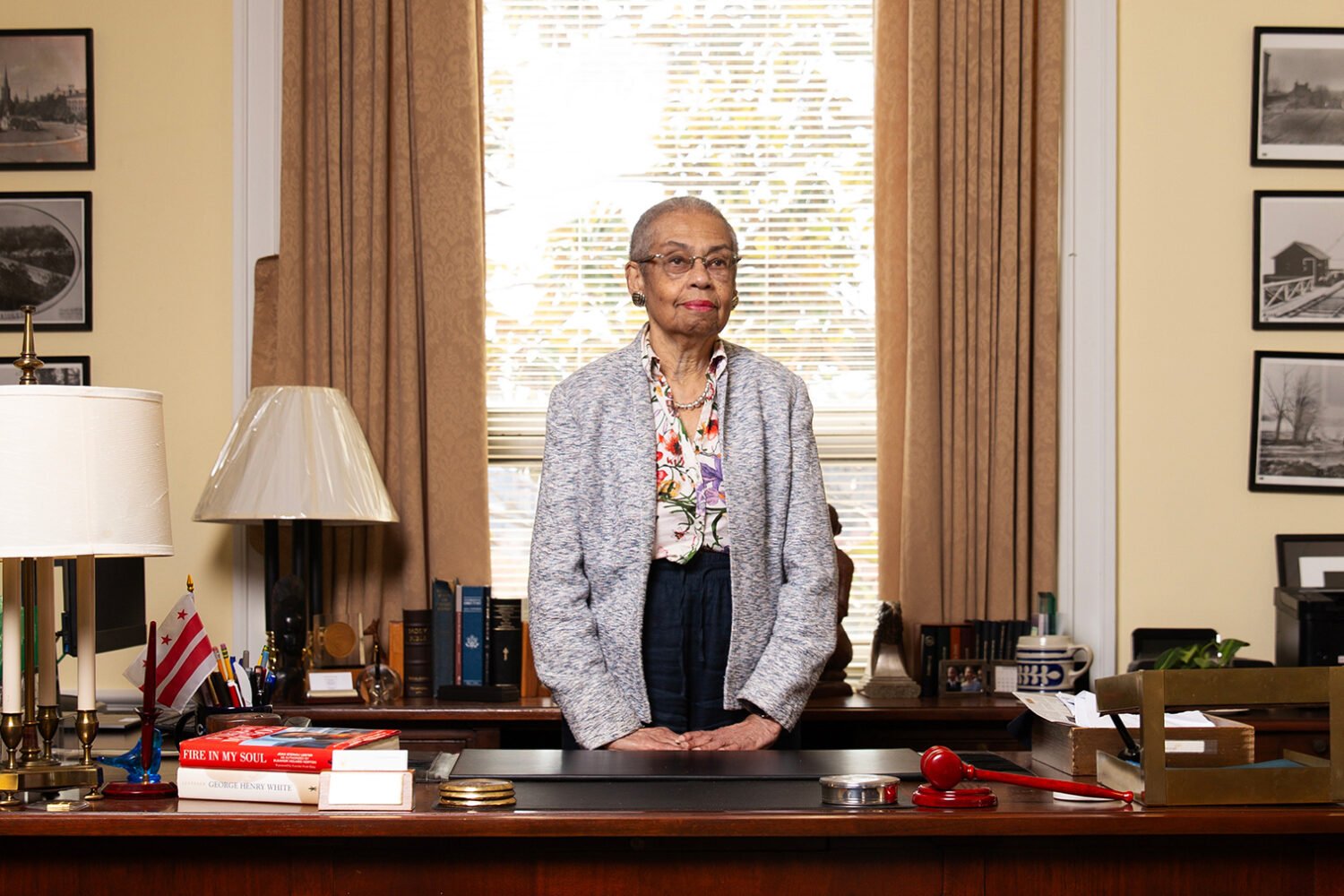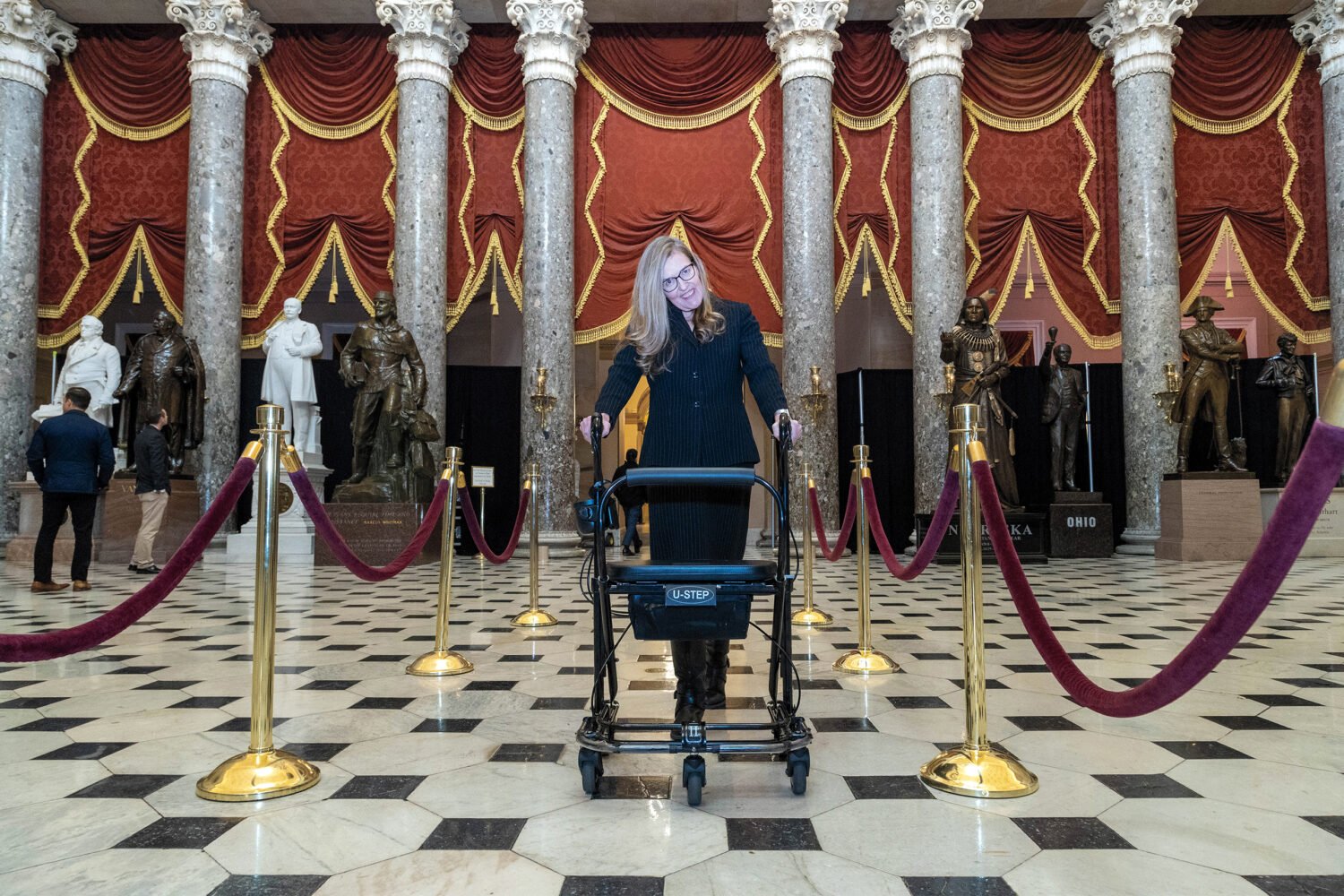One afternoon last fall, Gail Guttman, a therapist who works in Northwest DC and Montgomery County, was teaching a workshop on couples and sex therapy that took a highly unusual turn. During a break, her students—all licensed therapists themselves, in the class to hone their skills—went into the hallway and checked their phones for the first time since lunch. Some came back crying.
It was September 28, the day after Christine Blasey Ford testified in Congress that Brett Kavanaugh had assaulted her in high school, and the media was now reporting that his Supreme Court nomination would advance to the full Senate for a vote. Many of the therapists in Guttman’s class worked with sexual-assault survivors. Some had past traumas of their own. The news was crushing. Suddenly, no one could concentrate on the lessons at hand.
As a veteran mental-health professional, of course, Guttman had some moves to fall back on: Trying to get things back on track, she invited the group to talk about how they were feeling. She led a guided meditation. Then she moved on to her planned material, a role-playing demonstration. But as she was about to launch into her part, Guttman froze for a moment, something that had never happened in her 40 years in the business. “All of the things that I normally would have said . . . I didn’t do,” she tells me. “I felt lost.”
She pushed through the exercise, went home, got on with her evening. The following morning, however, she heard Blasey Ford’s voice on her car radio and fell apart weeping. The hearings were “traumatizing for me,” Guttman says, “but I had to hold myself together because I’m taking care of other people.”
Two and a half years into the Trump administration, it’s news to no one that the 45th President has generated angst in many people, regardless of party. The American Psychological Association has even documented the phenomenon. According to its 2018 Stress in America survey, 62 percent of Americans say the current political climate is “a significant stressor” for them; more than two-thirds say the nation’s future is stressing them out—a “significant increase” from 2017, the report says. “Trump May Not Be Crazy,” read a headline from Politico Magazine just before the survey came out, “But the Rest of Us Are Getting There Fast.”
In Washington, the malaise appears especially pronounced. I spent the last several months talking to nearly two dozen local therapists who described skyrocketing levels of interest in their services. They told me about cases of ordinary stress blossoming into clinical conditions, patients who can’t get through a session without invoking the President’s name, couples and families falling apart over politics—a broad category of concerns that one practitioner, Beth Sperber Richie, says she and her colleagues have come to categorize as “Trump trauma.”
In one sense, that’s been good news for the people who help keep us sane: Their calendars are full. But Trump trauma has also created particular clinical challenges for therapists like Guttman and her students. It’s one thing to listen to a client discuss a horrible personal incident. It’s another when you’re experiencing the same collective trauma.
“I’ve been a therapist for a long time,” says Delishia Pittman, an assistant professor at George Washington University who has been in private practice for 14 years. “And this has been the most taxing two years of my entire career.”
On Election Day in 2016, psychologist Julie Bindeman put on a white pantsuit, the outfit of choice for hardcore Hillary Clinton voters. She went to work excited about the prospect of America’s first female President. Like many therapists in Washington—in fact, all but one of those I contacted, at random, for this story—Bindeman votes Democratic. The following morning, she cried in the shower and had trouble preparing herself for the day.
Once at work, Bindeman saw seven clients, all but one of whom wanted to talk about Donald Trump’s surprise win. “I had clients who were traumatized” by it, Bindeman says. “And having to hear it all day, there was an element of trauma that my colleagues and I experienced.” She left the office completely overwhelmed.
“I can’t really say to my clients, ‘I don’t really want to hear any more about this topic.’ Though at times I want to!”
This wasn’t the first time local therapists experienced such universal trauma while on the clock, but it clearly doesn’t happen often—several compared the day after the election to 9/11 in terms of the mood in their office.
It wasn’t that a candidate had won on a right-wing platform: Even the most bleeding-heart Washington therapists have had plenty of experience with that, if they’ve been on the job long enough. Rather, it was that the campaign had involved so many new events nearly guaranteed to disturb mental-health clients as well as the people who work with them: the racist signs, the campaign-rally fisticuffs, and especially the Access Hollywood tape, with its evocations of violence against women.
It didn’t end with the campaign. The repeated breakdowns of societal and presidential norms—the empowerment of white nationalists, the name-calling from the Oval Office, and the ubiquitous social-media reminders of it all—have felt to many clients like a sustained assault on American institutions. Some federal employees, the bedrock of Washington’s economy and culture, feel that their life’s work has been upended. On a more prosaic level, they fear for their livelihoods.

For many, in other words, Trump-related anxieties originate from something more serious than mere differences about policy. The therapists I spoke to are equally upset—living through one unnerving news cycle after another, personally experiencing the same issues as their patients in real time while being expected to offer solace and guidance. As Bindeman told her clients the day after Trump’s election, “I’m processing it just as you are, so I’m not sure I can give you the distance that might be useful.”
This is a unique situation in therapy, where you’re normally discussing events in the client’s private life. How do you counsel a sexual-assault victim agitated by the Access Hollywood tape, for example, when the tape has also disturbed you—and when talking about it all day only upsets you further? How about a client who echoes your own fears about climate change or the treatment of minorities or the government shutdown, which had a financial impact on therapists just as it did everyone else?
Again and again, practitioners described different versions of this problem. Pittman, the GW professor, is an African American whose private-practice clients are mostly people of color and LGBT citizens who felt threatened by the ban on transgender people in the military or Trump’s comments about “very fine people on both sides” after the Charlottesville riots. She shared their fear and anger, she says, and it was a challenge to manage both at the same time: “Having this global pulse of pain on a really frequent basis just has been a lot in terms of managing your own personal well-being as a therapist.”
Bindeman specializes in issues around fertility and reproductive health and, like many of her clients, once had a medically necessary abortion. The week of the Kavanaugh hearings, which threw into doubt the future of Roe v. Wade, was particularly draining for her. Of course, any conservative President would have nominated conservative judges to the Supreme Court. But then Blasey Ford’s allegations turned Kavanaugh’s nomination into a double gut punch.
“Generally,” says Bindeman, “I am able to tolerate this really well and be okay for my clients. [But] when I’m hearing the pain of my clients and I’m hearing it amplified from everyone I’m around . . . it’s hard to feel like I can get that protective cocoon.”
Therapists are trained in keeping themselves healthy and sane, in strengthening that protective cocoon for themselves so they can provide it to others. But the Trump era—with its constant news bursts, amplified by pinging smartphone technology—has tested their ability to operate at a personal remove.
Richie counsels many survivors of sexual assault at her practice in Silver Spring. The last few years have been shattering for her clients, she says, and she has worked not to absorb their pain while at the same time feeling disturbed personally by current events. Recently, she cried throughout an entire synagogue service, nearly three hours long, when some passages in a prayer reminded her of a client. In 21 years of practice, this had happened to her only a small handful of times.
The problems that seem particularly taxing for therapists are those that are outside their control—i.e., addressing issues brought up by the politics of the day. Maryland psychologist Deepan Chatterjee recently saw an undocumented patient suffering from PTSD after a terrible work injury. Chatterjee tried to treat his symptoms and helped him contact an immigration lawyer, but there was little he could do to address the underlying issue: The stress of existing as an undocumented person in Trump’s America was greater than it had been under Obama. “It’s very difficult to treat a patient like this,” Chatterjee says. “This is not just anxiety he’s dealing with—it’s an existential crisis.”
Sometimes the President or another public figure can offer a helpful reference point.
Even for clients in less exigent circumstances, it’s hard for therapists to know what to do when the problem is not internal but external. “For most of my clients, they’re telling me something historical,” says a therapist who practices in DC and Maryland and asked to remain anonymous to talk openly about his work. “It’s a memory, and we can work on those memories and the beliefs associated with them from a distance.” When the problem is in the present and caused by presidential fiat, “it creates a certain feeling of helplessness” on the therapist’s part, he says. Right now, the politics of the day are a recurring feature of his sessions. He estimates that 90 percent of his clients regularly bring up current events, compared with maybe 5 percent before.
It’s . . . a lot to take. “I can’t really say to my clients, ‘I don’t really want to hear any more about this topic,’ ” he says. “Though at times I really want to do so!”
The constant presence of politics in the consulting room is coloring all kinds of interactions in atypical ways. In some sessions, the President or another public figure can offer a helpful reference point. “I said to someone in couples therapy, ‘You’re going all Kavanaugh on your wife, and it’s not working,’ ” recalls Jean Gearon, a psychologist with a practice in Foggy Bottom. Both members of the couple, she says, immediately understood what she meant.
Even the most routine interactions aren’t always immune to political asides. Chatterjee works in nursing homes, and part of his intake interview, assessing memory and awareness, is to ask the name of the current President. While many people say Trump’s name enthusiastically, Chatterjee says others refuse to utter it.
Then there are the clients whose politics the therapists abhor. As always, professionals in the field have to manage countertransference, their emotional response to clients. In training, they ideally build enough self-awareness to minimize negative reactions. But right now, some report having to work extraordinarily hard to interact with Trump supporters. “I had a few people who were kind of gloating [after the election],” a recently retired practitioner in Rockville told me. “That was really hard to take.”
Therapists have different approaches on how much to reveal when it comes to their own politics—an issue on which the field’s main professional organization, the American Psychological Association, provides no set guidelines. For some, revealing that they share a client’s views can have therapeutic value, showing a client that he or she is not alone. “You really want to validate what people are experiencing,” says Stephen Stein, a psychologist in Northwest DC. “The notion of false neutrality . . . of saying everything is the same, that’s not so.” For others, an appearance of neutrality feels necessary to make patients comfortable, even when it comes to hateful views.
The National Association of Social Workers’ code of ethics describes “social justice” as a primary core value of the profession, and all the social workers I spoke to (as well as many of the psychologists) viewed this work as fundamental: How can you heal an individual without also seeking to heal the culture?

But it can be complicated for therapists to engage in social-justice work at a time when that work is so politicized and might endanger a connection with clients who don’t share their views. The age of social media only exacerbates the pitfalls. Frederic Reamer, a social-work professor at Rhode Island College who has studied the changing ethics of therapy, points out that it’s easy now for clients to go online and figure out a therapist’s political affiliation, which can affect their comfort level going into a session. “I’m not always 100 percent neutral on my Twitter feed,” says Mary Alvord, a psychologist and professor in GW’s medical school, “so I have to be careful.”
Professional associations, though, are weighing in on policy. The social workers’ association has always been vocal when policies run contrary to its values, but since Trump took office, according to the group’s CEO, Angelo McClain, it has gone much further. Since 2016, the association has doubled the number of position statements and calls to action issued to its membership, in addition to ramping up a nonpartisan get-out-the-vote effort.
The American Psychological Association, meanwhile, has traditionally been less willing to wade into politics, but even that stance has changed over the past two years. The organization has issued condemnatory public letters about things like the repeal of the DACA immigration policy and the detention of children at the border, among other issues. “Where we have science that speaks to the damages that occur when you strip people of their rights, that is absolutely the APA’s responsibility to speak on that,” says Vaile Wright, the organization’s director of research and special projects.
Bindeman, the fertility specialist, serves on the legislative committee at the Maryland Psychological Association and says she’s seen many of her peers feel “compelled to be more in a psychologist-activist role.” Watching so many people take on that voice has been healing, she adds: It’s “given me hope.”
A week after Trump’s election, Gearon, the DC psychologist in Foggy Bottom, invited the eight members of her book club over to vent and brainstorm. Forty-five women came, and Gearon—who says she had never even voted in local elections before—formed an advocacy group to ramp up voter engagement. Two years later, she was a speaker at the 2018 Women’s March. Activism has become her coping mechanism. As she puts it, “If I can’t find hope, how can I be supportive and calm and steady with the clients with whom I work?”
Therapists are often in therapy themselves, and they have access to so-called consultation groups, or regular gatherings of fellow practitioners who meet to talk shop and swap advice. Richie, the therapist who works with sexual-assault survivors, has seen a recent uptick in requests to run self-care workshops for employers, and those double, she says, as personal self-care: Leading a guided meditation for others also calms her down. The retired Rockville therapist says that when she counseled patients to tend to themselves—with a yoga class, healthy eating, time to unwind—the advice resonated back to her as well. “The things we say to our clients are, just by virtue of having them come out of our mouths, helpful for us, too.”
Over the past two years, however, many therapists reported that their need for self-care measures such as massages and pedicures, deep breathing, or extra sets at the gym had gone through the roof. Bindeman, a casual exerciser before the 2016 election, now knocks out an intensive workout six days a week because “that’s what I need to feel functional.” After a 13-year hiatus from tae kwon do, she took it up again and just got her black belt.
Several therapists describe a much more urgent reliance on colleagues and explain how that communal support is itself therapeutic . Reamer, the ethics expert, says he has seen therapists reaching out to other therapists “more frequently, with more intensity, and in some cases with more exasperation than I’ve ever seen in my career.” For Richie, her regular consultation group of other therapists now spends a lot of its time on the politics that show up in the consulting room. “I honestly don’t think I could do this work if I didn’t have that group of psychologists to turn to,” she says.
Some practitioners are finding that it feels good to face politics head-on. Stein, the psychologist in Northwest DC, ran support groups for people traumatized by the election and found his own angst cooled at the same time. “If you create communities where people can join together . . . it’s a way of dealing with the sense of distress,” he says. Chatterjee and his wife started a political podcast, Between the Beltways, on which they discuss local races in Montgomery, Prince George’s, and Howard counties.
But for others, unplugging from Facebook or going on a news diet has become essential. Victoria Sylos-Labini, a psychologist in Dupont Circle, will sometimes take a Saturday off from all media. (It’s not any easier for therapists than for the rest of us, it turns out.)
Pittman, of GW, says she spent “so much money” on spa treatments at the beginning of the Trump administration in order to take care of herself, the better to tend to her clients. More recently, she’s been allowing herself one mental-health day per month, up from the two or three a year she used to take.
“I try to do as little as possible,” she says, describing her routine. “Sometimes I shower, sometimes I don’t. Sometimes I brush my teeth, sometimes I don’t until 7 pm.” She has splurged on restorative accessories for her home—recognizing that if she doesn’t feel comfort, she can’t comfort anyone else. “If I’m only going to get five hours of sleep,” she says, with a dry laugh, “I’m going to get the $300 linens.”
This article appears in the July 2019 issue of Washingtonian.








